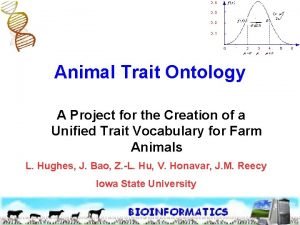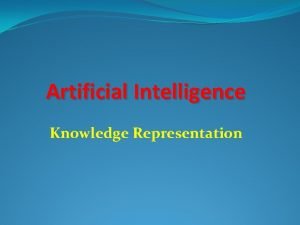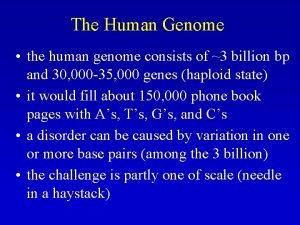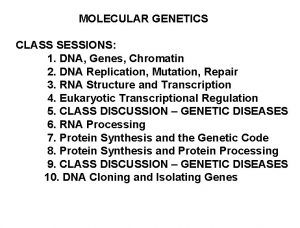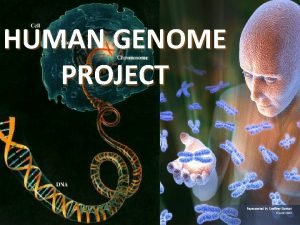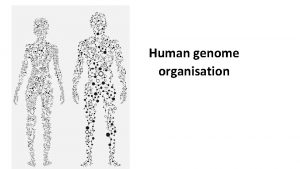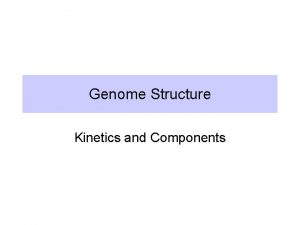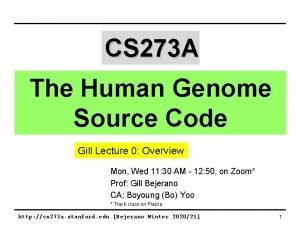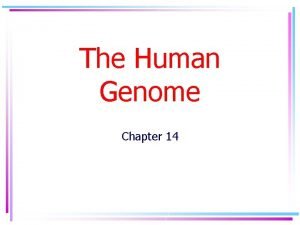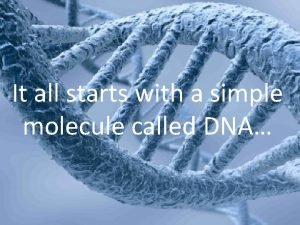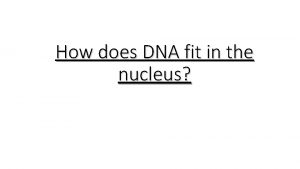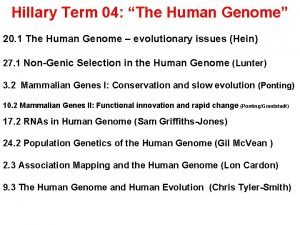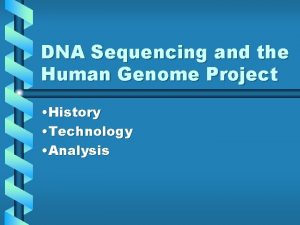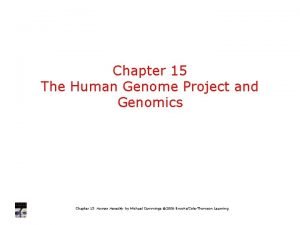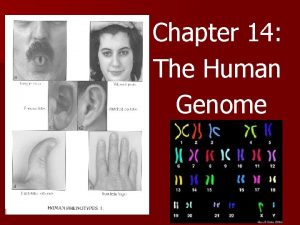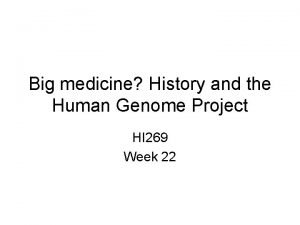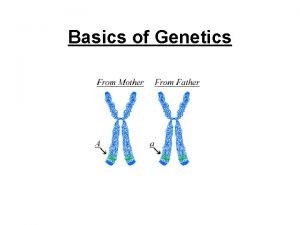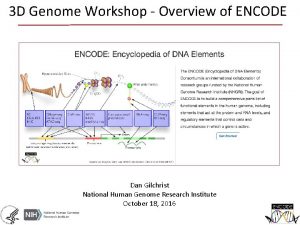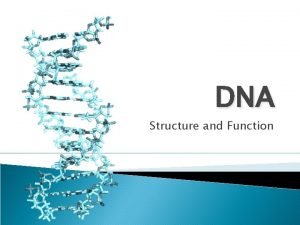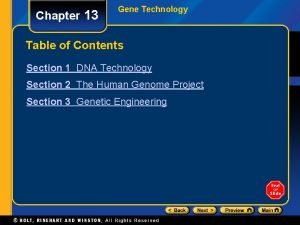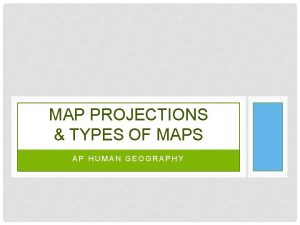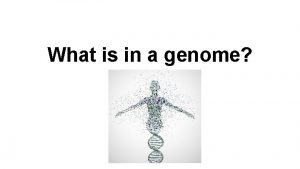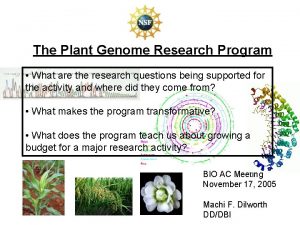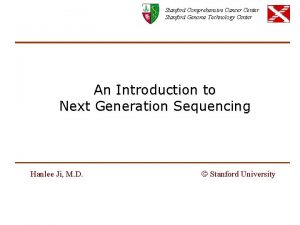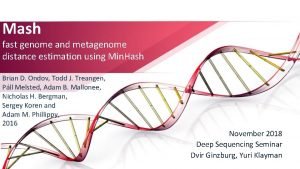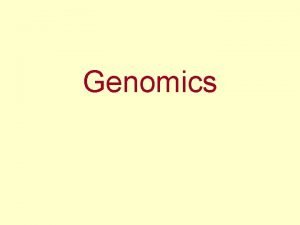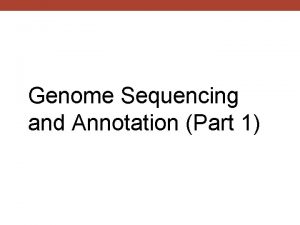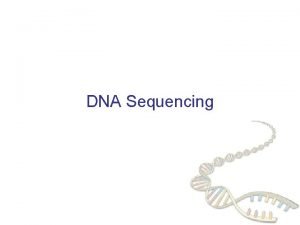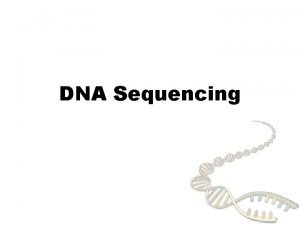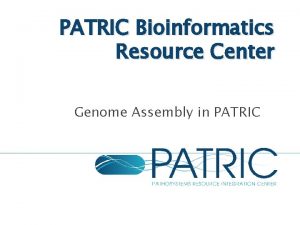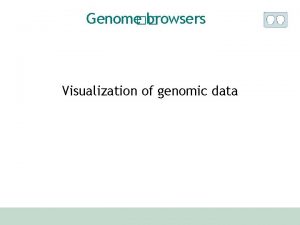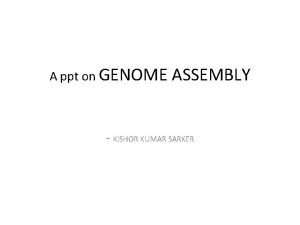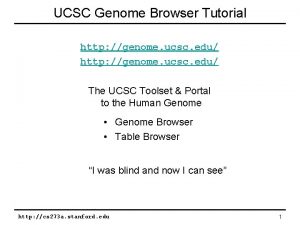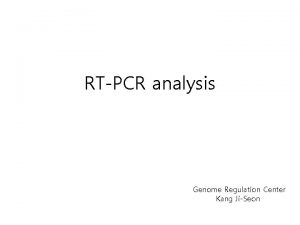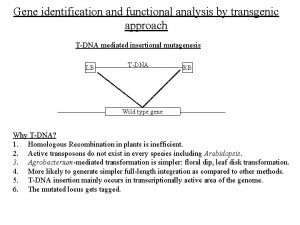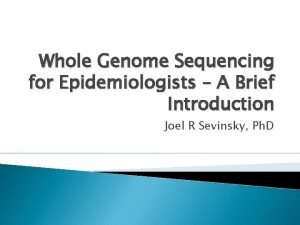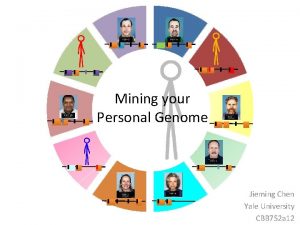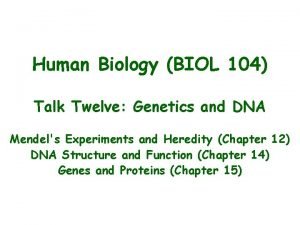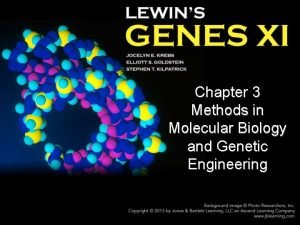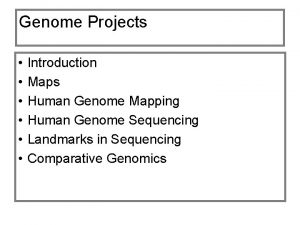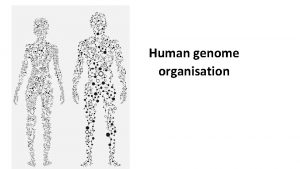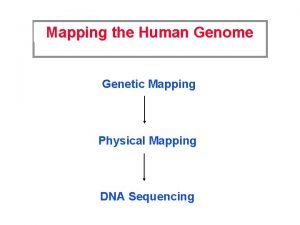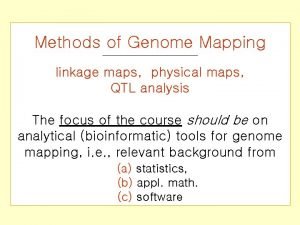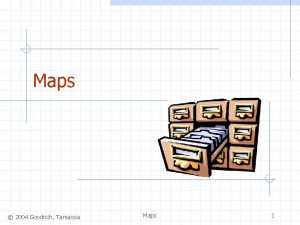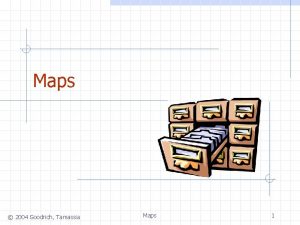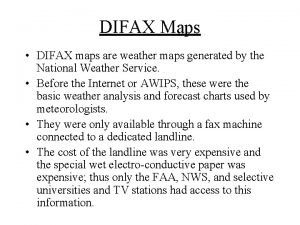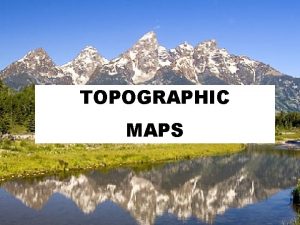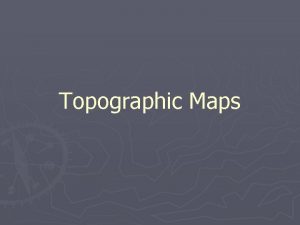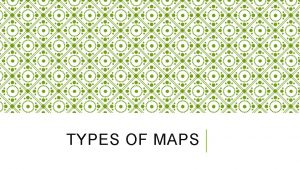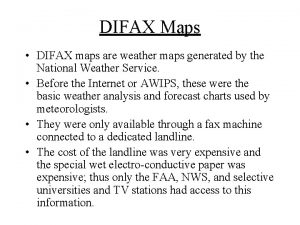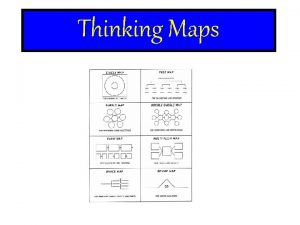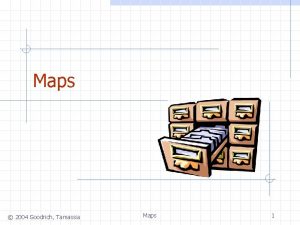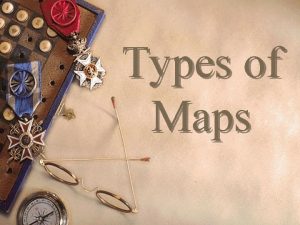Genome Projects Maps Human Genome Mapping Human Genome





















































- Slides: 53

Genome Projects • • • Maps Human Genome Mapping Human Genome Sequencing Landmarks in Sequencing Comparative Genomics The Tree and Our Place on It

Genome Projects: Maps – Cytogenetic maps • Low resolution (each band = several Mb) • Chromosome banding – Restriction maps • Rare-cutting restriction enzymes • Resolution - Several hundred kb – Clone contig maps • Overlapping YAC/cosmid clones • Resolution – 10 s of kb to several hundred

Genome Projects: Maps – STS maps • Sequence tagged site • PCR of known sequence to identify location • Resolution – 10 s of kb – EST maps • Sequence c. DNAs and locate on other physical maps • Resolution ~90 kb – DNA sequence • Resolution – 1 bp


Genome Projects: Maps • Progress in human gene mapping – Slow when compared to Drosophila and mouse – Speed increased when non-coding markers began being used in conjunction with familial patterns of linkage


Genome Projects: Sequencing • Landmarks in genome sequencing


Genome Projects: Sequencing • Progress in human genome sequencing – Hierarchical vs. whole genome shotgun sequencing – Precision and accuracy – Repetitive DNA

08_03. jpg


Genome Projects: Sequencing • Progress in human genome sequencing – Hierarchical vs whole genome shotgun sequencing – Landmark papers in Nature and Science (2001) • Venter et al Science 16 February 2001; 291: 13041351 • Lander et al Nature 409 (6822): 860 -921

Genome Projects: Sequencing • A typical high-throughput genomics facility


Genome Projects: Sequencing • BLAST/BLAT and other tools – BLAST - Basic local alignment search tool • Input a sequence and find matches to human or other organisms – publication information – DNA and protein sequence (if applicable)





Genome Projects: Sequencing • BLAST/BLAT and other tools – BLAT – BLAST-like alignment tool • A “genome browser” • Genomes available: – human, chimp, dog, cow, mouse, opossum, rat, chicken, Xenopus, Zebrafish, Tetraodon, Fugu, nematode (x 3), Drosophila (x 5), Apis (x 3), Saccharomyces (yeast). • Off-slide show example: chr 6: 121, 387, 504121, 720, 836

Genome Projects: BLAT • BLAT and other tools – Off-slide show example: chr 6: 121, 387, 504121, 720, 836 • • • STS and RH markers Known genes (alternative splices of genes) Conservation with other genomes Known single nucleotide polymorphisms (SNPs) Repetitive DNA

Our Place in the Tree of Life: Genome Evolution • Endosymbiont hypothesis


Our Place in the Tree of Life: Genome Evolution • Gene duplication – Acquisition of novel functions


Our Place in the Tree of Life: Genome Evolution • Gene duplication – Paralogous chromosome segments – Ancient genome duplications – Hox gene clusters


Our Place in the Tree of Life: Genome Evolution • Concerted evolution – – members of a sequence of families in a species evolve together so that they maintain high similarities among themselves while diverging from members of other species – via gene conversion – example primate photoreceptors


Primate ancestor X-linked pigment gene Divergence NWM X-linked pigment gene Gene duplication OW primates X-linked pigment genes

If duplication occurred before human-OWM split, divergence between genes should be comparable (~7. 1%) Baboon divergence of exons 4 and 5 b/t genes = 11% Human divergence of exons 4 and 5 b/t genes = 8% Baboon divergence of intron 4 b/t genes = 0. 5% Human divergence of intron 4 b/t genes = 0. 0%

Our place in the tree of life • Exon duplication and shuffling – Examples – May be mediated by mobile elements


Our Place in the Tree of Life: Genome Evolution • Mammalian phylogeny


Our Place in the Tree of Life: Genome Evolution • Conservation between mouse and man – Limited to subchromosomal regions – Variable rates of amino acid sequence divergence



Our Place in the Tree of Life: Genome Evolution • Human evolution – Determining our place in the tree • Cytogenetic analysis • Gene content analysis • Sequence analysis – Intron and exon sequences, mt. DNA sequences • SINE analysis


Phylogenetic Inference Using SINEs

Phylogenetic Inference Using SINEs Species A Species B Species C Species D

Resolution of the Human: Chimp: Gorilla Trichotomy (H, C)G (H, G)C (C, G)H (H, C, G)

Phylogenetic Analysis §PCR of 133 Alu loci § 117 Ye 5 § 13 Yc 1 § 1 Yi 6 § 1 Yd 3 § 1 undefined subfamily PNAS (2003) 22: 12787 -91

Alu Elements and Hominid Phylogeny PNAS (2003) 22: 12787 -91

Our Place in the Tree of Life: Genome Evolution • Human evolution – Coalescence analyses (mt. DNA and Y chromosome) – Mutiregional vs. Out of Africa • Predictions of the Multiregional Hypothesis – Equal diversity in human subpopulations – No obvious root to the human tree • Predictions of the Out of Africa Hypothesis – Higher diversity in African subpopulations – Root of the human tree in Africa



Population Relationships Based on 100 Autosomal Alu Elements Africa Asia Europe S. India

Europe Low diversity 0. 1 0. 6 Africa High diversity 0. 3 0. 9 Australia Low diversity

Our Place in the Tree of Life: Genome Evolution • Human evolution – Higher diversity in African subpopulations • Insulin minisatellite Table 12. 6 in text • 22 divergent lineages exist in the human population • All are found in Africa. Only 3 are found outside of Africa.


 Genome-to-genome distance calculator
Genome-to-genome distance calculator Genome mapping
Genome mapping Maps reittihaku
Maps reittihaku Procedural versus declarative knowledge in ai
Procedural versus declarative knowledge in ai The associative mapping is costlier than direct mapping.
The associative mapping is costlier than direct mapping. Forward mapping vs backward mapping
Forward mapping vs backward mapping Transform mapping dan transaction mapping
Transform mapping dan transaction mapping The human genome consists of
The human genome consists of Human genome size
Human genome size Human genome size
Human genome size Bacterial artificial chromosome slideshare
Bacterial artificial chromosome slideshare Strs and vntrs
Strs and vntrs Human genome structure
Human genome structure Human genome project source code
Human genome project source code Sickle cell karyotype
Sickle cell karyotype National human genome research institute
National human genome research institute National human genome research institute
National human genome research institute Human genome project code
Human genome project code History of human genome project
History of human genome project Chapter 15
Chapter 15 Chapter 14 the human genome
Chapter 14 the human genome Human genome project
Human genome project National human genome research institute
National human genome research institute Encode
Encode 14-3 human molecular genetics
14-3 human molecular genetics Who discovered the structure of dna
Who discovered the structure of dna Chapter 13 section 3 the human genome
Chapter 13 section 3 the human genome Projects abroad human rights office
Projects abroad human rights office Ap human geography types of maps
Ap human geography types of maps What is a formal region
What is a formal region Map types
Map types What is a genome
What is a genome Plant genome research program
Plant genome research program Stanford genome technology center
Stanford genome technology center Mash distance
Mash distance Per partes
Per partes Hierarchical shotgun sequencing vs whole genome
Hierarchical shotgun sequencing vs whole genome Shotgun sequencing
Shotgun sequencing Dna
Dna Patric genome
Patric genome Genome modification ustaz auni
Genome modification ustaz auni Genome klick
Genome klick Genome assembly ppt
Genome assembly ppt Genome.ucsc.edu tutorial
Genome.ucsc.edu tutorial Genome
Genome Functional dna
Functional dna Genome sequencing
Genome sequencing Marc fiume
Marc fiume Jieming chen
Jieming chen Genome research limited
Genome research limited 1000 genome project
1000 genome project Consensus sequence in prokaryotes
Consensus sequence in prokaryotes Genome.gov
Genome.gov Genome research limited
Genome research limited

